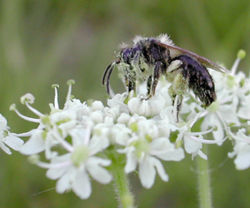Apocrita
| Apocrita | ||||||||||
|---|---|---|---|---|---|---|---|---|---|---|
 Andrena sp.
|
||||||||||
| Scientific classification | ||||||||||
|
||||||||||
| Superfamilies | ||||||||||
|
Apocrita is a suborder of insects in the order Hymenoptera.
The Apocrita includes wasps, bees and ants, and consists of many families. It includes the most advanced Hymenoptera and is distinguished from the Symphyta by the narrow "waist" (petiole) formed between the first two segments of the actual abdomen; the first abdominal segment is fused to the thorax, and is called the propodeum. Therefore, it is general practice, when discussing the body of an apocritan in a technical sense, to refer to the mesosoma and metasoma (or "gaster") rather than the "thorax" and "abdomen," respectively. The ovipositor of the female either extends freely or is retracted, and may be developed into a sting for both defense and paralyzing prey. Larvae are legless and blind, and either feed inside a host (plant or animal) or in a nest cell provisioned by their mother.
The Apocrita has historically been split into two groups, the "Parasitica" and the Aculeata, but these are rankless groupings in present classifications, if they appear at all. The Parasitica is an artificial (paraphyletic) group comprising the majority of Hymenopteran insects, with respective members living as parasitoids on what amounts to nearly "every other species of insect", and many non-insects. Most species are small, with the ovipositor adapted for piercing. In some hosts the parasitoids induce metamorphosis prematurely, and in others it is prolonged. There are even species ("hyperparasites") that are parasitoids on other parasitoids. The Parasitica lay their eggs inside or on another insect (egg, larva or pupa) and their larvae grow and develop within or on that host. The host is nearly always killed. Many parasitic Hymenoptera are used as biological control control agents to control pests, such as caterpillars, true bugs and hoppers, flies, and weevils.
The Aculeata is a monophyletic group that includes those species in which the female's ovipositor is modified into a "stinger" to inject venom rather than eggs. Groups include the familiar ants, bees and various types of parasitic and predatory wasps; it also includes all of the social Hymenoptera.
Among the non-parasitic and non-social Aculeata, larvae are fed with captured prey (typically alive and paralyzed) or may be fed pollen and nectar. The social Aculeata feed their young prey (paper wasps and hornets), or pollen and nectar (bees), or perhaps seeds, fungi, or even non-viable eggs (ants).
Extant Families & Superfamilies
- Suborder Apocrita
- (unranked) Aculeata
- Superfamily Apoidea (bees and sphecoid wasps)
- Family Andrenidae (mason bees)
- Family Apidae (carpenter bees, digger bees, cuckoo bees, bumble bees, orchid bees, stingless bees, and honeybees)
- Family Colletidae (yellow-faced bees and plasterer bees)
- Family Dasypodaidae
- Family Halictidae ("sweat bees")
- Family Megachilidae (leaf-cutting bees)
- Family Meganomiidae
- Family Melittidae
- Family Stenotritidae
- Family Ampulicidae (cockroach wasps)
- Family Crabronidae (sand wasps, bee wolves, etc.)
- Family Heterogynaidae
- Family Sphecidae (digger wasps)
- Superfamily Chrysidoidea
- Family Bethylidae
- Family Chrysididae (cuckoo wasps)
- Family Dryinidae
- Family Embolemidae
- Family Plumariidae
- Family Sclerogibbidae
- Family Scolebythidae
- Superfamily Vespoidea
- Family Bradynobaenidae
- Family Formicidae (ants)
- Family Mutillidae (velvet ants)
- Family Pompilidae (spider wasps)
- Family Rhopalosomatidae
- Family Sapygidae
- Family Scoliidae
- Family Sierolomorphidae
- Family Tiphiidae
- Family Vespidae (paper wasps, potter wasps, hornets, pollen wasps, yellowjackets)
- Superfamily Apoidea (bees and sphecoid wasps)
- (unranked) Parasitica
- Superfamily Ceraphronoidea
- Family Ceraphronidae
- Family Megaspilidae
- Superfamily Chalcidoidea
- Family Agaonidae (fig wasps)
- Family Aphelinidae
- Family Chalcididae (chalcid wasps)
- Family Eucharitidae
- Family Eulophidae
- Family Eupelmidae
- Family Eurytomidae (seed chalcids)
- Family Leucospidae
- Family Mymaridae (fairyflies) - the smallest of all insects
- Family Ormyridae
- Family Perilampidae
- Family Pteromalidae
- Family Rotoitidae
- Family Signiphoridae
- Family Tanaostigmatidae
- Family Tetracampidae
- Family Torymidae
- Family Trichogrammatidae
- Superfamily Cynipoidea
- Family Austrocynipidae
- Family Cynipidae (gall wasps)
- Family Figitidae
- Family Ibaliidae
- Family Liopteridae
- Superfamily Evanioidea
- Family Aulacidae
- Family Evaniidae (ensign wasps)
- Family Gasteruptiidae
- Superfamily Ichneumonoidea
- Family Braconidae
- Family Ichneumonidae (ichneumon wasps)
- Superfamily Megalyroidea
- Family Megalyridae
- Superfamily Mymarommatoidea - sometimes called Serphitoidea
- Family Mymarommatidae
- Superfamily Platygastroidea
- Family Platygastridae
- Family Scelionidae
- Superfamily Proctotrupoidea
- Family Austroniidae
- Family Diapriidae
- Family Heloridae
- Family Maamingidae
- Family Monomachidae
- Family Pelecinidae
- Family Peradeniidae
- Family Proctorenyxidae
- Family Proctotrupidae
- Family Roproniidae
- Family Vanhorniidae
- Superfamily Stephanoidea
- Family Stephanidae
- Superfamily Trigonaloidea
- Family Trigonalidae
- Superfamily Ceraphronoidea
- (unranked) Aculeata
References
- Grimaldi, D. and Engel, M.S. (2005). Evolution of the Insects. Cambridge University Press. ISBN 0-521-82149-5.
External links
- Suborder Apocrita - Ants, Bees and Wasps - BugGuide.Net — images and other information
- Balades Entomologiques — "entomological walks" with images (French)